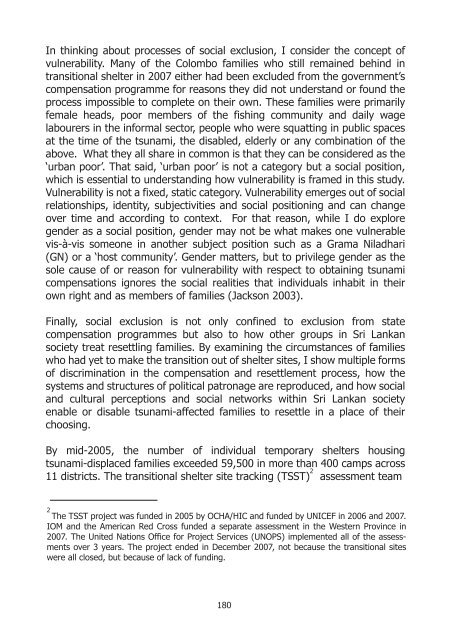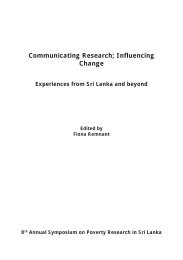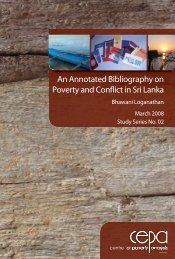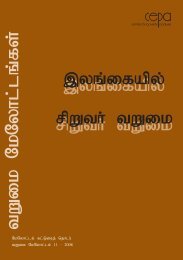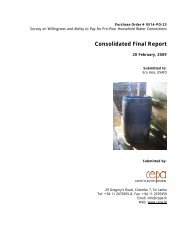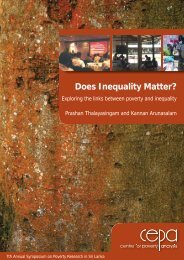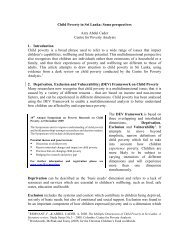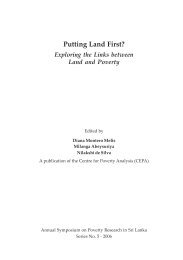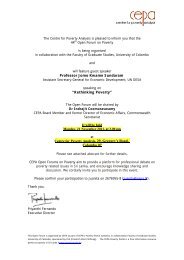Involuntary Displacement and Resettlement â Policy and ... - CEPA
Involuntary Displacement and Resettlement â Policy and ... - CEPA
Involuntary Displacement and Resettlement â Policy and ... - CEPA
- No tags were found...
Create successful ePaper yourself
Turn your PDF publications into a flip-book with our unique Google optimized e-Paper software.
In thinking about processes of social exclusion, I consider the concept ofvulnerability. Many of the Colombo families who still remained behind intransitional shelter in 2007 either had been excluded from the government’scompensation programme for reasons they did not underst<strong>and</strong> or found theprocess impossible to complete on their own. These families were primarilyfemale heads, poor members of the fishing community <strong>and</strong> daily wagelabourers in the informal sector, people who were squatting in public spacesat the time of the tsunami, the disabled, elderly or any combination of theabove. What they all share in common is that they can be considered as the‘urban poor’. That said, ‘urban poor’ is not a category but a social position,which is essential to underst<strong>and</strong>ing how vulnerability is framed in this study.Vulnerability is not a fixed, static category. Vulnerability emerges out of socialrelationships, identity, subjectivities <strong>and</strong> social positioning <strong>and</strong> can changeover time <strong>and</strong> according to context. For that reason, while I do exploregender as a social position, gender may not be what makes one vulnerablevis-à-vis someone in another subject position such as a Grama Niladhari(GN) or a ‘host community’. Gender matters, but to privilege gender as thesole cause of or reason for vulnerability with respect to obtaining tsunamicompensations ignores the social realities that individuals inhabit in theirown right <strong>and</strong> as members of families (Jackson 2003).Finally, social exclusion is not only confined to exclusion from statecompensation programmes but also to how other groups in Sri Lankansociety treat resettling families. By examining the circumstances of familieswho had yet to make the transition out of shelter sites, I show multiple formsof discrimination in the compensation <strong>and</strong> resettlement process, how thesystems <strong>and</strong> structures of political patronage are reproduced, <strong>and</strong> how social<strong>and</strong> cultural perceptions <strong>and</strong> social networks within Sri Lankan societyenable or disable tsunami-affected families to resettle in a place of theirchoosing.By mid-2005, the number of individual temporary shelters housingtsunami-displaced families exceeded 59,500 in more than 400 camps across11 districts. The transitional shelter site tracking (TSST) 2 assessment team2The TSST project was funded in 2005 by OCHA/HIC <strong>and</strong> funded by UNICEF in 2006 <strong>and</strong> 2007.IOM <strong>and</strong> the American Red Cross funded a separate assessment in the Western Province in2007. The United Nations Office for Project Services (UNOPS) implemented all of the assessmentsover 3 years. The project ended in December 2007, not because the transitional siteswere all closed, but because of lack of funding.180


